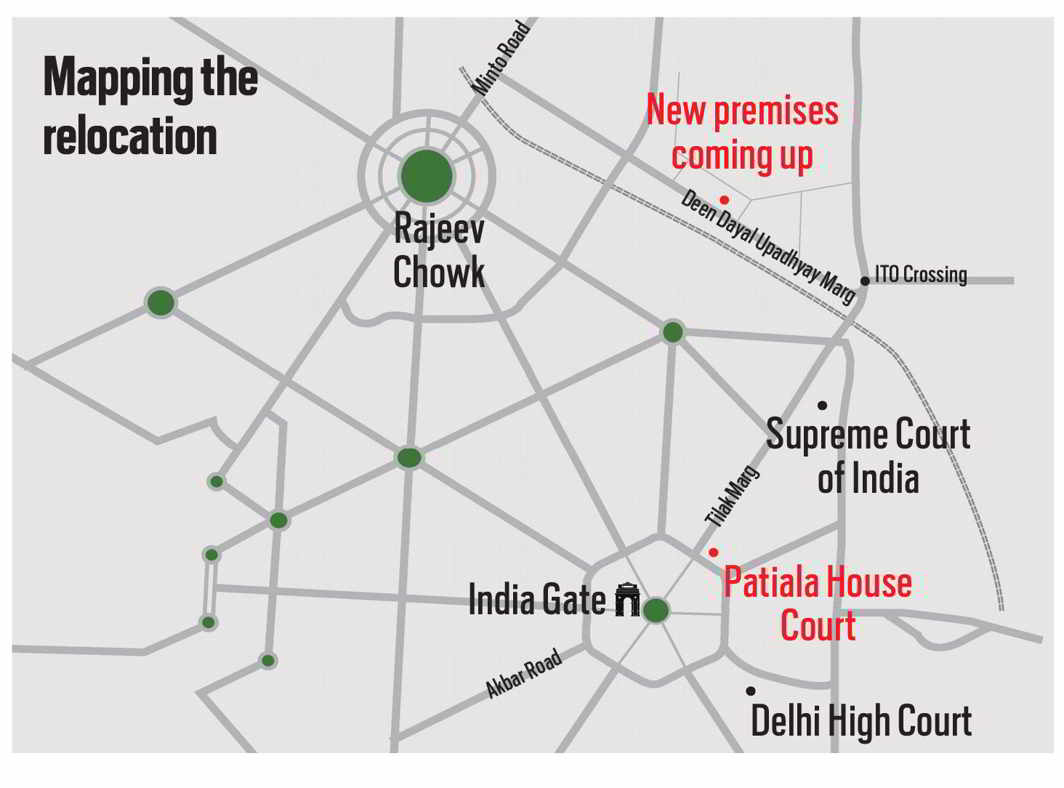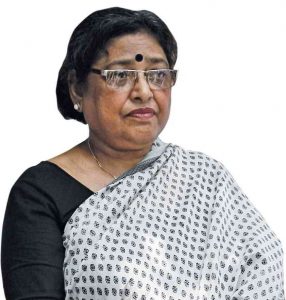
The decision of the Delhi government to shift congested quarters of Patiala House Court to a new complex in Deen Dayal Upadhyay Marg has not gone down well with lawyers. What are their grouses?
~By Deepti Jain
The Indian judiciary often works under many constraints, one of which is infrastructure which hasn’t kept pace with requirements. Take the 7.87-acre Patiala House Courts (PHC) in central Delhi. In 2013, the Delhi government under Chief Minister Sheila Dikshit decided to relocate the congested PHC to a modern district complex on Deen Dayal Upadhyay Marg. However, despite the new complex, which is still being built (at a cost of Rs 306 crore), and standing on an area of five acres, lawyers of PHC are unhappy with the move.
India Legal visited the new site at DDU Marg and found that the complex has chambers only for judges, not for lawyers. With some 1,700 lawyers having either a chamber or a seat in PHC, their fate now hangs in the balance. The new building is a seven-storey glass edifice which has four court rooms and five bar rooms on each floor which belong just to one court. Bar rooms, incidentally, are public areas with no privacy if lawyers need to meet clients or prepare for cases. The PHC, on the other hand, has 32 courts and one family court. Advocate Neeraj, secretary of Bar Association of PHC said more land should be allocated near the new building so that individual lawyers’ chambers can be made.
Delhi’s district courts
- Tis Hazari
- Karkardooma
- Patiala House
- Rohini Court
- Dwarka Court
- Saket Court
A junior engineer of the Public Work Department (PWD) told India Legal that “work on the new building was 80 percent complete”. The centrally air-conditioned building has been constructed in accordance with the green building concept, for which a certificate is still pending. “This building has been engineered with fly ash bricks; has a water-harvesting system, solar panels for lighting and environment friendly tiles. In two years, PWD has used up Rs 265 crore of the allocated sum of Rs 306 crore,’’ he said.
He admitted that there was a dire need to allocate more space, especially for parking of police vans and vehicles of lawyers and the public. The present provision is for only 810 cars, whereas in PHC, it was 2,000.
The project is set for completion in December and after that, it will be handed over to the Delhi government. The High Court will then take a call when to shift.
The Maharaja Connection
A brief history of Patiala House Court
- Patiala House, designed by British architect Sir Edwin Lutyens, is situated at Tilak Marg near India Gate in central Delhi
- It is the former palace of the Maharaja of Patiala
- When Indira Gandhi was the PM, she abolished privy purses in 1970 and took over the palace
- As the population of Delhi grew, in March 1997, Patiala House was converted into a court complex and criminal courts from Parliament Street were shifted there
Another problem for lawyers is of jurisdiction. The capital is divided into 10 police districts. PHC deals with criminal cases of New Delhi, South and South-West districts. However, the new complex, said advocate Santosh Mishra, falls in the jurisdiction of IP Estate police station. “This is problematic as getting a court complex outside one’s own jurisdiction is against the rule of law.” (See Box)
The rationale behind the concept of jurisdiction is that a court should be able to adjudicate only in those matters which fall within the geographical, political or pecuniary limits of its authority. These can be defined by three aspects:
- The place where the action has taken place/FIR was filed (civil and criminal matters)
- The place where the applicant resides (mostly in civil matters)
- The place where the defendant resides (mostly in civil matters)
Supreme Court advocate Gopal Srinivas said the new building has been built in breach of Supreme Court orders and a 2000 judgment on the bifurcation of district courts. “I don’t find any relevant reason for shifting the courts to a new place when it is already functioning properly. Why create unnecessary hurdles? This construction is a sheer waste of public money,” he said.

However, SC advocate Rajesh Kumar said that even if the Courts are shifted to DDU Marg, there would be no conflict of interest. The new courts will continue to deal with matters related to the areas assigned to lawyers.
“Why are there no lawyers’ chambers in the new complex?”
 SANTOSH MISHRA, New Delhi Bar Association President, talks to DEEPTI JAIN about the hurdles in shifting to the new complex at Deen Dayal Upadhyay (DDU) Marg
SANTOSH MISHRA, New Delhi Bar Association President, talks to DEEPTI JAIN about the hurdles in shifting to the new complex at Deen Dayal Upadhyay (DDU) Marg
The construction of the new building is almost complete. Have you received any notification from authorities?
No, no notification has been sent to us regarding the shifting of the Court. Even if the notification comes from the Delhi government, the whole Court cannot be shifted as the area at DDU is like a matchbox. You can’t force lawyers to share their chambers.
What do lawyers want?
A choice should be given to the lawyers whether to shift or not, as many have been sitting at Patiala House Court (PHC) for decades. Also, as per the mutual consent between Delhi government and the Delhi HC, it was decided in the backdrop of the 2006 Rohini District Court agitation, that this new building would have chambers for lawyers too.
All district courts in the capital —Saket, Dwarka, Karkadooma and Rohini—have a separate building for lawyers’ chambers. So why haven’t authorities incorporated this basic thing in their new building here?
What is the jurisdiction conflict in this case?
This new building falls in the jurisdiction of IP Estate police station, whereas PHC falls under New Delhi district. Getting a court complex outside one’s own jurisdiction defeats the very purpose of having justice at one’s doorstep. Plus, it is against the rule of law. PHC lawyers should be given the choice whether to shift or not.
How many lawyers are there presently in PHC and how many of them don’t have chambers? How can this problem be solved?
Approximately 1,700 lawyers are practising in this court and there is a shortage of 400-500 independent chambers. We cannot add another floor in PHC as this is a heritage structure and was the former palace of the Maharaja of Patiala. We need more space to accommodate the remaining lawyers and want to be shifted close to the PHC area as it falls under New Delhi’s jurisdiction.
Incidentally, Patiala House is the former palace of the Maharaja of Patiala. When Indira Gandhi became the prime minister, she abolished privy purses in 1970 and the royal family sold the palace to the government. However, there were reports that the palace still belonged to Capt Amarinder Singh of Patiala.
India Legal spoke to Atul Nanda, advocate-general of Punjab, who clarified that Captain Singh had not filed any case with regard to getting the palace back. “Also, I am not aware that the PHC is shifting,” he said.
Poonam A Bamba, District and Sessions Judge at Patiala House Courts, too said she had no idea regarding any case filed by Amarinder Singh in this regard. This was seconded by Devendra Kumar, Chief Prosecutor at PHC, who too said he was not aware of any such case.
Palace Makeover
In 1920, the British established the Chamber of Princes by a royal proclamation of King-Emperor George V. This was meant to provide a forum for the rulers of the princely states to voice their needs to the colonial government and ended the policy of isolating them. It first met on February 8, 1921 and initially consisted of 120 members.
They usually met once a year with the Viceroy of India presiding. Gradually, these rulers built their own palaces in Delhi. They were given plots around India Gate which was the Prince’s Park and that is how various houses such as Baroda, Patiala, Jaipur and Bikaner came into being.
However, these were all taken over by Indira Gandhi when she abolished the privy purses in 1971. Gradually, these grand and stately palaces were transformed into government offices, hotels, courts, etc. The opulent and stately Hyderabad House, the palace of the seventh Nizam, Mir Osman Ali Khan, is now used for official banquets and meetings with heads of states. Recently, Prime Minister Narendra Modi met Palestinian President Mahmoud Abbas there.
Jaipur House became a museum for modern art, Baroda House is being used as the Zonal Headquarters Office of the Northern Railways and Bikaner House was used for government offices and a bus terminal till it was given back to the Rajasthan government last year. Travancore Palace at Kasturba Gandhi Marg has been transformed into a cultural complex.
Interestingly, Mandi House, the former residence of the Raja of Mandi, located at Copernicus Marg, Delhi, was built on nine acres, while other states were not allowed more than eight acres. It was demolished to make way for modern offices, including Doordarshan.
This is not the first time that lawyers are protesting against the shifting of the courts. A similar incident took place in 2006 when the Rohini District Complex was set up without any provision for lawyers’ chambers. Then, the Delhi Bar Association had observed a strike for a day. Mishra said PHC lawyers should be given the choice whether to shift or not, as many have been operating from these courts for the past three decades. She said the shifting would create a financial dent for advocates who own chambers there.
Another issue irking lawyers is the chaotic traffic on DDU Marg as it is located near the offices of various political parties. They claim this will only increase traffic snarls.
Location, after all, is everything.

